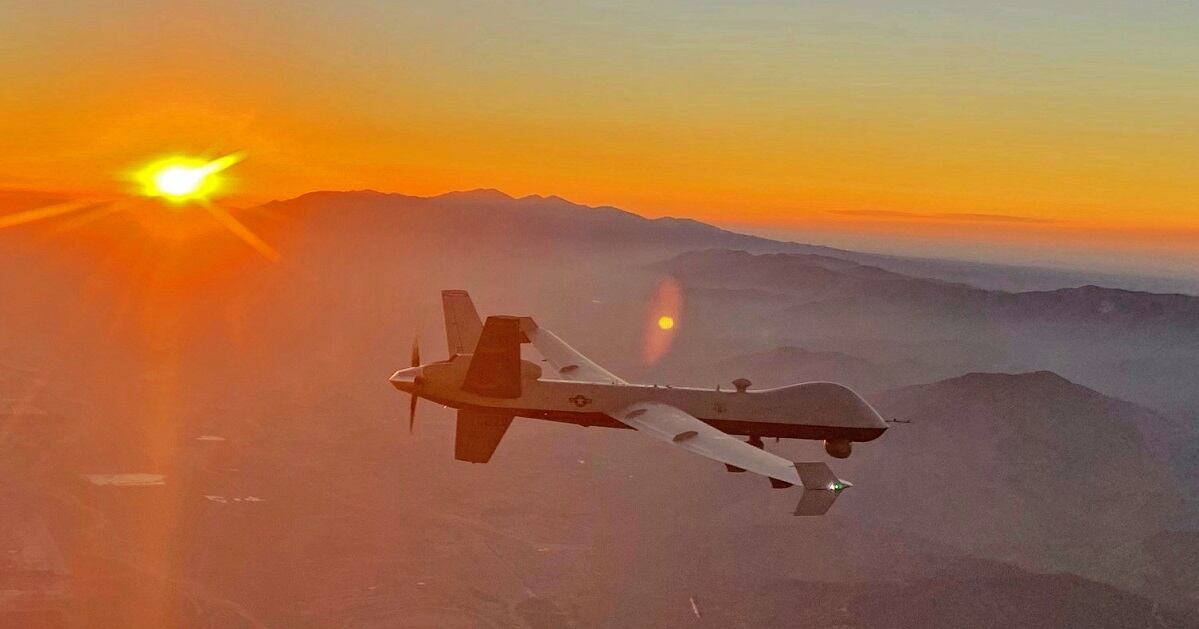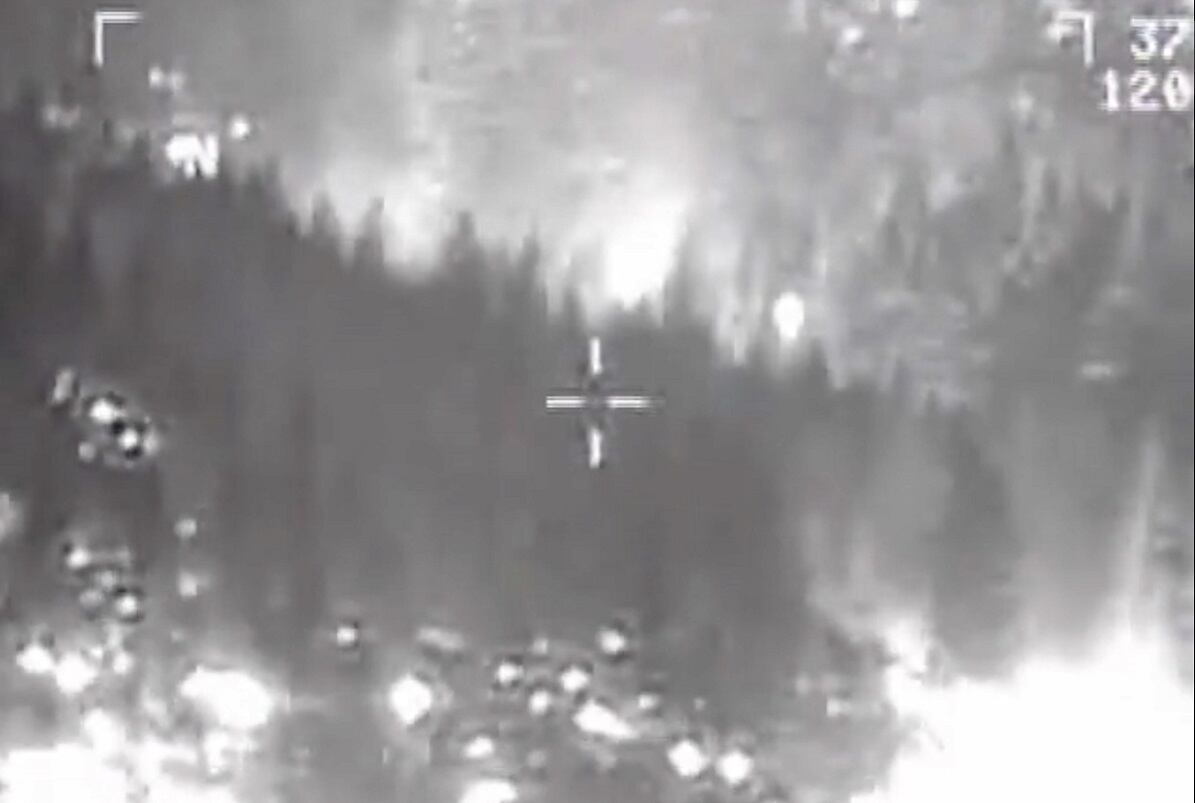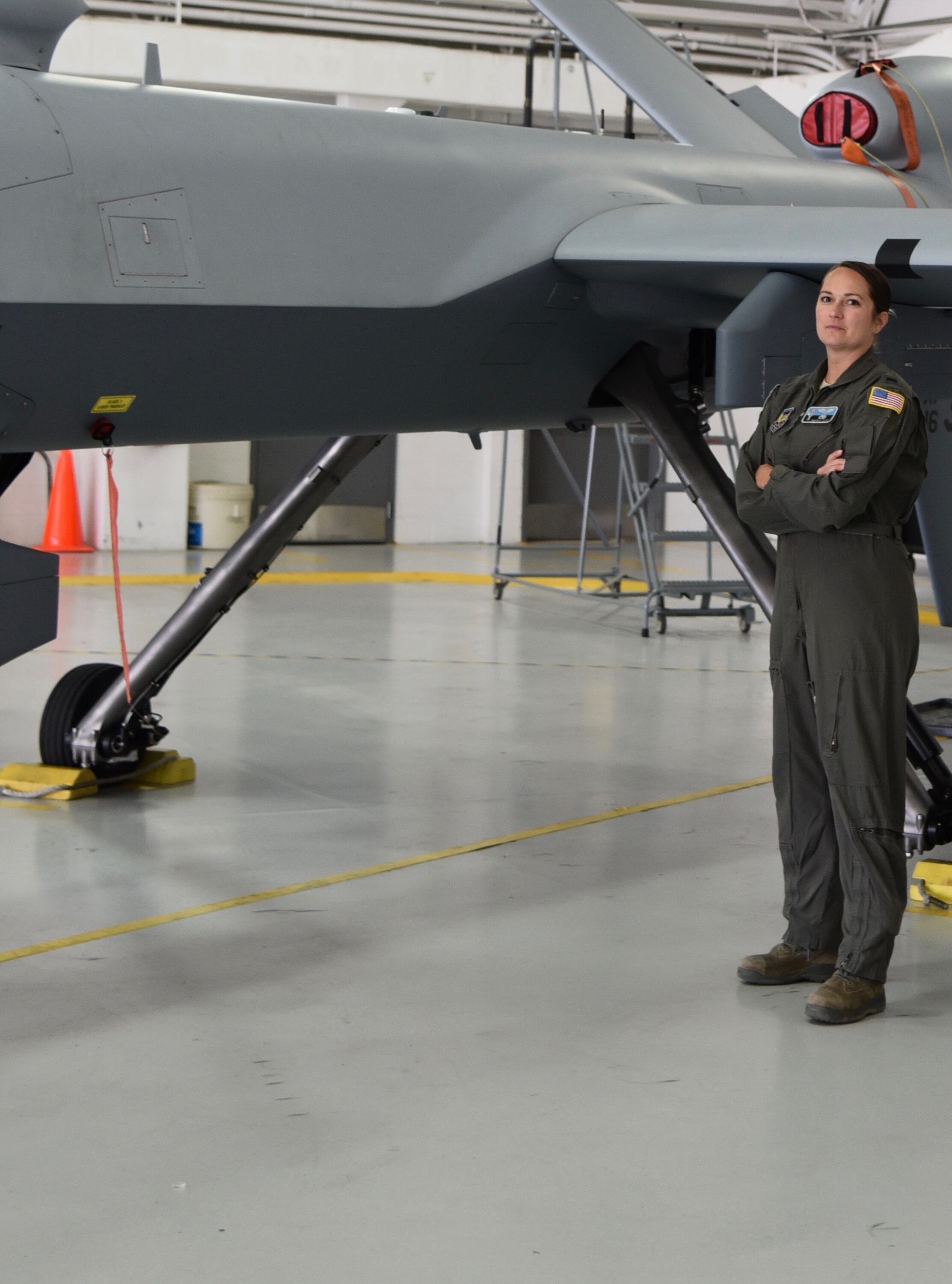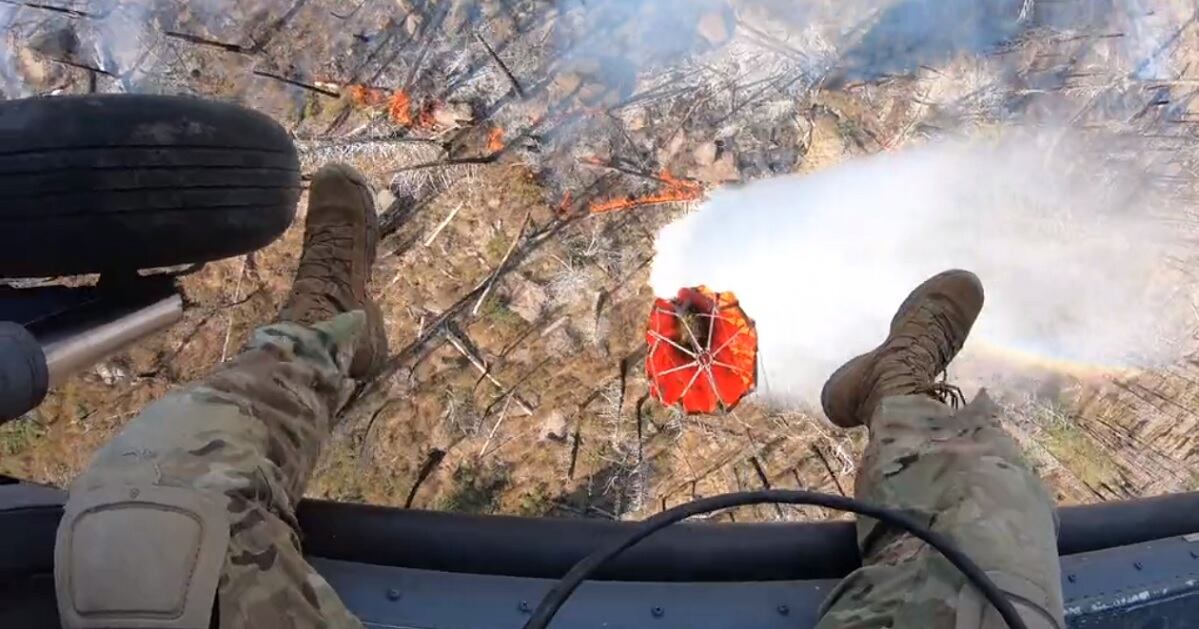As large fires continue to ravage the western United States, elements of the Air National Guard in California and from across the U.S. have been sent in to assist on the ground and in the air, sending C-130s, drones, helicopters and other aircraft high above the flames and billowing smoke.
Sparked by “dry lightning” from August thunderstorms, and possibly electrical lines, Washington, Oregon, California and Colorado have seen a record number of acres burned this year.
Some 70,000 Southern California residents were were ordered to evacuate their homes Wednesday as two new fires erupted and merged within 48 hours.
Three more of California’s large wildfires are not yet contained, with more than 1.5 million acres scorched already. Washington has more than five active major fires, which have burned more than 952,000 acres. Oregon currently has seven active fires that have spread over more than 838,000 acres.
Colorado recently suffered its largest wildfire in history, with some 207,000 acres burned. The Centennial State currently has three major fires burning, with a total of more than 342,000 acres burned, though no Air Guard elements from the 140th Air Wing have been dispatched to assist there. Luckily, a snowstorm snuffed much of the blaze, but not before it destroyed 442 structures, 222 of which were residences.
The western states have enlisted their own resources to battle the infernos, which continue to flare up, testing the limits of their assets and often requiring extra help from beyond their borders.
The ANG continues its support, partnering with state and local agencies to provide important air assets, including drones armed with sensors to help firefighters on the ground predict fire behavior.

This year has been a challenge, said Lt. Col. Devin T. Robinson, director of public affairs for the ANG. “And our Guard Airmen have risen to meet those challenges at every turn.”
Robinson told Air Force Times in an email that airmen from all over the country have answered the call to assist California with its wildfires, using RC-26 reconnaissance cargo planes, MQ-9 drones, C-130 firefighting planes, HH-60G Pave Hawks and more.
Airmen from California, Michigan, Nevada, New York, Washington and Wyoming were recently activated to assist in fighting the West Coast wildfires.
It’s only been in recent years that drones like the MQ-9 have been used to fight wildfires. The first such ANG firefighting mission was in 2013 in California’s Yosemite National Park.
Armed with electro-optical and infrared sensors used for targeting, the 4,900-pound MQ-9 is able to fly 1,150 miles for more than 24 hours to map terrain through smoke and at night to identify the perimeters of a fire.

California
The California Department of Forestry and Fire Protection, or CAL FIRE, said it had the support of its state’s ANG, which brought out three MQ-9 Reapers to help map fires.
“We’ve been using the MQ-9s out of March (Air Reserve Base) for probably most of the fire events that have been going on since mid-August,” CAL FIRE spokesperson Lynne Tolmachoff told Air Force Times by phone. “Their capabilities are a tremendous help to us. They have technology that’s not available to us, so we definitely count on them for the information that they can give us.”
CAL FIRE manages more than 31 million acres of land, and had roughly 12,000 firefighters on the ground as of Wednesday. California has seen fire activity on more than 3.7 million acres of land since August, with 4.1 million acres burned since the beginning of the year — about 4 percent of the entire state.
"With the winds … [fires can] grow quickly, just like we had with the recent Zogg Fire and the Glass Fire, Tolmachoff said. “So, we’re not out of the woods yet. We haven’t seen rainfall, especially with any significance that would help put an end to fire season, so we still have a ways to go until we can actually say that we can relax a little bit.”
Many units of the California Air National Guard responded, including HH-60G Pave Hawk helicopter crews with the 129th Rescue Wing, which dropped buckets of water on the wildfires in support of CAL FIRE.
The California ANG flew three MQ-9s daily over many of the state’s fires. Master Sgt. Paul D. Brady, a domestic operations supervisor and imagery analyst for the 234th Intelligence Squadron, told Air Force Times in a phone interview that his unit has saved lives.

“During one of the fires, some embers had blown across one of the firebreaks that they had set up and because of the dense terrain and vegetation, the firefighters on the ground were not able to see they had a fire start up behind them,” Brady said. “We were able to identify that and relayed that information to them and they were able to reallocate different assets and get the fire extinguished.”
Brady said if the fire had not been extinguished, it would have endangered the lives of the firefighters and could have spread into residential areas.
As crews are on the ground battling the blaze, the drones are out of sight, partly because of smoke, but also because they’re flying in areas where the firefighters are not.
“Especially this fire season, we’re dealing with a lot of fires in a lot of real, real extreme terrain where firefighters just could not get access to,” Brady said.
When asked what he thought about using a weapon of war in firefighting efforts, Brady responded that as a drone analyst “it’s always nice to see that the efforts that you are doing are directly affecting the communities in the state that you live in.”
“A lot of times, analysts, if they’re doing their job right, no one knows about it," Brady said. “With these fires, they can actually see the result of what they’re doing and that’s always an added perk to working state missions.”
California is fortunate to have drones like the MQ-9 at its disposal to provide that eye-in-the-sky support for firefighters, said Lt. Col. Jonathan Shiroma, public affairs director for the California National Guard.
“This is such a timely piece of equipment to have and be able to use because it does save lives and it does help predict what could happen, just based on what behavior they see with any given conflict that’s going on,” Shiroma said. “That’s a real key asset that this provides to our civilian partner agencies in a time of need.”
An underutilized tool
During the Creek Fire, an MQ-9 was able to identify the locations of about 214 hikers so Army National Guard helicopters could come in to rescue them.
Capt. Nicole Clay, an MQ-9 pilot with the 174th Attack Wing in Syracuse, New York, volunteered to fly California missions for several weeks in August and September to support firefighting efforts.
She wasn’t “in the seat” piloting the drone when the hikers were located, but she was briefed on it the next morning, she told Air Force Times in a phone interview.
One limitation that makes domestic operations like supporting firefighting efforts somewhat tricky is privacy, she said.
“So, we weren’t able to watch civilians and make sure they got escorted out, so we were very eyes-off once that happened,” Clay said. “They don’t want us to be, quote, ‘spying’ on civilians.”

If, for example, a drone feed captured someone in the act of starting a fire, the operator would not be able to follow him because of current privacy regulations in place, she said.
“Which is hurtful for me, as a civilian and a former California resident, to be able to get that and have to look away.”
Clay believes that as drones are used more and more, and the public becomes more familiar with them and their capabilities as life-saving tools, the rules and laws governing their use will evolve.
When asked about the contrast between missions, Clay said it “was a nice change” going from flying combat missions to supporting domestic operations.
“We’re utilizing the same tools, so I had the background to do it, it’s just utilizing it in the way of fire tracing,” Clay said. “I’ve never done that — mapping where the fires are going, searching for hotspots, we were doing overhead support for the firefighters as they were fighting the fires and they were focusing on the fires. We would watch around them just to make sure the fires wouldn’t sneak up behind them and close off their exit points.”
Clay said the MQ-9 is a seriously underutilized asset that she’d like to see used in more state emergency situations.
“I just want people to be able to see this technology and view it in a different light,” Clay said. “I think people only see it as that technology that goes overseas and kills bad guys.”
Oregon
During the Labor Day weekend alone, Oregon had more than 30 wildfires burning simultaneously, with over 7,500 personnel working to put them out, Jim Gersbach, Oregon Forestry Department spokesperson, told Air Force Times in a phone interview.
The Oregon ANG in September sent some 125 guardsmen from the 142nd and 173rd Fighter Wings to help with fire emergency response efforts in the Beaver State.

Col. David Unruh, commander of the 142nd Wing in Portland, said his state was pretty much on its own during its fire woes. The ANG coordinated with local and state agencies, but was only able to deploy about 150 airmen — with no drones — carrying everything from their personal tents to “swing shovels” to put out fires.
“It was like any other deployment where we call them, but they’re showing up in their firefighting uniform,” Unruh said. “We throw them on buses with their equipment and they hump it out into the field and set up their tents. … It’s kind of funny because it looks like a military encampment, but if the military went to REI (the camping supply store) with everyone bringing their civilian tents.”
Early in the summer, Unruh’s airmen went through training offered by fire experts to earn their “red card,” or fire certification.
“The folks who went out and did this are some of the folks that I, literally, just got them back from a deployment,” Unruh said. “It’s humbling, sitting here in the wing commander’s office and watching them do it, because I remember watching them get off the airplane just a few weeks ago.
"I’m watching them roll out the front gate to go — literally go to save their state. I’m really proud of the people in this age of doing more with less. … I’m proud of them.”
Jared is the manager of print design for Sightline Media Group's five magazines under the Military Times and Defense News banners.





